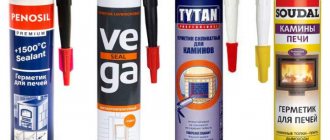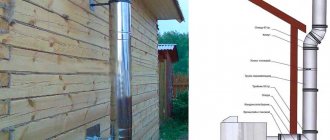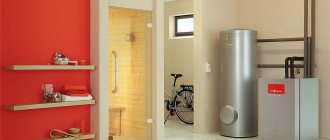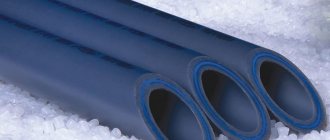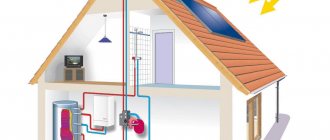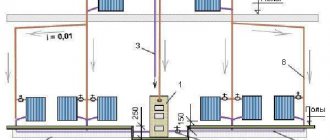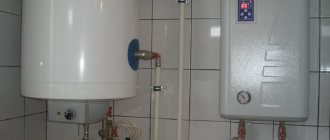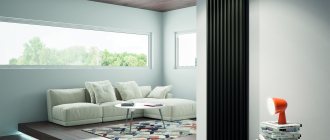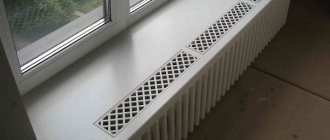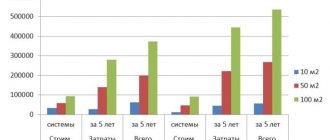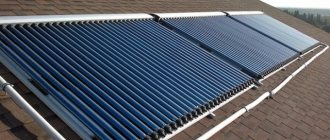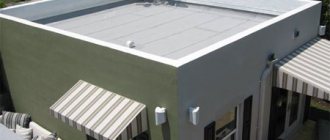Before starting the assembly and installation of a chimney made of stainless steel, experienced specialists carry out preparatory installation work. To do this, experts suggest using a special type of sealant that can withstand temperatures up to 1000 C. It is with this substance that all seams and subsequent joints in the internal cavity of the chimney pipes will need to be treated.
In addition, the sealant serves as an additional guarantee of the tightness of the product, because in some cases even welding can “retreat.” There is no need to use sealant on the outer surface of a stainless steel chimney. You can find a review of stainless steel sandwich chimneys here.
The photo shows stainless steel chimneys.
How to assemble?
The entire design of the stainless steel chimney is very simple. Therefore, you can assemble such a chimney with your own hands. Review of technical characteristics and elements of stainless steel chimneys here: https://mykaminz.ru/dymoxod/vidy/nerzhavejka/obzor-texnicheskixe-xarakteristik-i-elementov-dymoxodov-iz-nerzhaveyushhej-stali.html.
The main rule to remember when assembling is to treat the connecting elements of the stainless steel chimney pipe with special care and precision.
The entire structure must be strengthened with additional elements in the form of clamps. If the chimney is purchased, then all elements must be included. Clamps are placed at each joint of the product - this is approximately every 1.5-2 meters.
In order to assemble a stainless steel chimney, it is necessary to take into account many nuances. In the event that actual experience is not enough, then you need to take the advice of professionals. If there are no such specialists around, then before assembling such a structure you need to carefully study the video material presented below.
Only if the assembly of the device is done correctly will it be possible to obtain a sealed and reliable chimney.
How to install?
In accordance with the general rules for installing stainless steel chimneys, installation should be done from bottom to top. This means that first they fix the part of the chimney that is attached to the heating device and only then move on to the remaining elements of the structure.
Then each pipe is fixed.
They are mounted as follows: the side with a smaller diameter is attached to a pipe with a larger diameter. This method of forming the structure will prevent moisture and dirt from entering the internal cavity of the chimney. Read an overview of the characteristics of a galvanized steel chimney on this page.
Attention! The maximum depth of the mounting area is 0.5 times the outer diameter of the stainless steel pipe.
The maximum size of one element of the “highway” cannot exceed one and a half meters.
At the joints of the product, clamps made of brass or stainless steel should be used. In order to fix the device, you should use special brackets and bolts marked M10 and M8.
Attention! All components of the structure should under no circumstances interact with gas pipes and the electrical wiring system.
To care for a stainless steel chimney, you need to install a small door at the very bottom of the device.
In order to simplify the entire process of installing a stainless steel chimney as much as possible, you should prepare a design diagram in advance. In addition, such a drawing will allow the owner of the building to orient himself regarding the overall dimensions of the entire structure and determine the number of all component parts of the device.
Advice: you should purchase 30% more material, because during the installation process it will be difficult to be distracted from work. It requires composure and attentiveness.
If some elements are a little taller or longer, they can be shortened a little. If the fastening element fails for some reason, you will not need to run to the store “for more.” Read the review of stainless steel chimneys.
To carry out installation work on stainless steel chimneys, you must follow the instructions and use high-quality fasteners. If your own experience is not enough to install such a chimney, you can use the video material presented below:
Installation of a stainless steel chimney with a passage through the ceiling and roof
According to experienced specialists, if even after studying the material and the advice of the experts, confidence in your own abilities has not increased, it is worth using the services of specialists. This is the only way to save your own time and money.
Requirements for chimneys for gas boilers
The chimney for the boiler must meet certain characteristics and standards, otherwise problems will most likely arise in subsequent use. For example, here are the basic rules for a chimney:
The slope that is permitted should in no case exceed 30 degrees, regardless of location. The length for the side “shoots” should not exceed the permissible values, namely 100 cm. It is prohibited to intentionally or arbitrarily make protrusions or ledges in the channel. Sections located transversely are prohibited due to a violation of the drainage system and the passage of draft. The number of tees is no more than three. It is allowed to make curves, but remember that their radius should not be lower than the diameter of the chimneys. In turns, it is better to provide in advance for the installation of special “containers” for collecting condensate, as well as hatches for prevention. In the event that for the chimney they chose to use a channel that is not round, but say oval or even elongated rectangular, then the width of one of the sides should not exceed twice the width of the other side. At the very bottom of the channel there is a “drip tank” and a moisture collector. Even minimal deflections of the system are prohibited. Take into account the fact that when installing several sections, they must be inserted into each other by at least 0.5 whole parts from the original diameter. Any gaps between are prohibited. Please note that in places where it is necessary to install ceilings or in walls, it is prohibited to skip non-solid sections. The connection is made either before or after the pass. The connection must be tight; use additional special tools. Remember one more important factor: the slope of the chimney towards the heat source cannot be more than 0.01 degrees. Do not forget that the inner walls should be as smooth as possible
Even small roughnesses create an obstacle to the passage of soot, which subsequently accumulates there. Consider two rules: the length of the horizontal section for buildings that are still at the construction stage should be no more than 300 cm, for houses already built no more than 600 cm. Also remember that the distance between the pipe and the finishing material, ceiling, if it is not flammable must be more than 250 mm. or 50 mm. if the material is fire resistant. In places where the smoke exhaust duct needs to be routed through the ceiling, high-quality thermal insulation is made.
Height standards
Requirements for the chimney when installing a gas boiler
As you can see, the requirements for chimney channels for gas boilers are quite serious and should not be neglected. In addition to the listed points, there are also special standards for the device regarding height. So:
- If the distance from the pipe installed on the roof to the ridge is more than 300 cm, then you have complied with the standard values. This arrangement is allowed without increasing the height of the chimney.
- At the same level with the ridge, you need to install pipes that are located at a distance of more than 150 cm.
- If the distance is less than 150 cm, it rises to a height of up to 50 cm from the ridge.
In addition, remember the rule: if the roof has a common roof and is flat, the roof top rises at least 50 cm.
How to clean?
Any device requires good treatment and care, the same goes for a stainless steel chimney.
It is in order to be able to clean the device that a small door or so-called glass is installed in its lower part. This element can be removed and the inner surface of the pipes can be cleaned. Read an overview of the types of chimneys for a fireplace.
Dirt in a system is the formation of a space with a high level of roughness, and this has a direct impact on the functionality of the device and the operation of the entire system.
An ash pan is also specially installed for comfortable maintenance of a stainless steel chimney. Solid combustion elements will collect in it.
The picture shows the installation of a stainless steel chimney.
Preliminary calculation of the chimney system
Schematic diagrams for installing stainless steel chimneys
When planning the installation of a stainless chimney, it is necessary to take into account several important criteria, which are provided for by special fundamental documents of the technical supervision service:
1. The total height of the chimney cannot be less than 5 m - to ensure normal draft.
2. The construction of horizontal sections more than 1000 mm in length is not allowed.
3. In unheated rooms or in open space (on the street), the installation of elements that do not have their own thermal insulation is prohibited.
4. Particular attention to the excess of the chimney cut above the roof:
- If the roof is flat - at least 500 mm.
- The same requirements apply if the distance from the pipe to the ridge of the pitched roof is less than 150 cm.
- At a distance of 150 to 300 cm, the pipe must be at least level with the height of the ridge.
- At large distances, the pipe cut should not be below a line of 10º from the ridge height horizon.
- There are situations when other buildings are attached to the main building. In this case, the height of the pipes must be at least higher than their upper level.
5. If the chimney passes through a roof made of flammable materials, a spark arrester must be installed.
6. The most critical areas are passage through walls, ceilings, and roofs, especially if they are made of flammable materials. If the pipe is uninsulated (single-walled), then the distance between it and the ceiling must be at least 1000 mm. This, in fact, is not practiced, but even with a sandwich thickness of 50 mm, the minimum gap should be 200 mm.
7. Pipe joints in thick walls or ceilings are not allowed. Minimum distance from floor, ceiling, wall – 700 mm
8. When a chimney passes even through a non-combustible roof, the minimum gap between the pipe and the covering cannot be less than 130 mm.
9. Two basic rules must be taken into account:
- On a horizontal or inclined section from a heating device or stove, pipes are installed “along the smoke”, i.e. so that combustion products move freely along the internal channel. In practice, this is a pipe that is put on the previous one from the boiler.
- On the vertical section of the chimney, the opposite is true - installation is carried out “through condensation”, so that the resulting moisture “has no chance” of getting into the insulation. Thus, each subsequent pipe section is inserted into the underlying one.
10. The diameter of the pipe at any of its connections cannot be less than the standard outlet pipe of the heating device.
11. The total number of chimney turns, regardless of their angle, is no more than three.
The chimney may have an internal layout, passing through the premises of the house. In this case, either thermally insulated sandwich pipes are used, or the chimney itself can be covered with brickwork.
Indoor chimney diagram
Recently, with the widespread use of double-layer insulated parts, its external placement, with brackets attached to an external wall, has become a more popular scheme.
The location of the chimney outside on brackets...
or with the installation of a special supporting structure made of a metal profile.
...or on a special supporting structure.
The advantages of this arrangement are obvious - there is no need to arrange complex thermally insulated passages through the interfloor ceilings and roof.
A stainless steel chimney burned out, what should I do?
The service life of a stainless steel chimney can last several decades.
But, troubles also happen. For example, one of the parts of the device may burn out. Repairs can be carried out in two ways:
- complete replacement of the element; local repair.
The first option involves replacing the entire section of pipe, but the second option involves the use of additional construction equipment. The damaged area is repaired using welding. It should be reinforced with stronger metal.
Advantages of a stainless steel chimney
Stainless steel chimneys have been approved by stove owners due to such advantages as:
- long-term operation;
- impeccable wall strength;
- ease of installation;
- safety and increased strength;
- acceptable price.
A stainless steel chimney is much stronger than its brick counterpart. If sharp temperature changes are not reflected in any way on the metal surface, then brick is especially sensitive to them and can crumble.
A stainless steel chimney has many advantages, the main one of which is a durable body
What is most impressive is the resistance of the stainless steel chimney to moisture. A pipe made of this metal remains impervious to corrosion, regardless of the degree of air humidity in the room.
The stainless steel chimney is a structure of separate modules, which is why it can be repaired without any problems by replacing the damaged part with a new one. The installation of this smoke channel is carried out using special bends. With them, engineering systems and architectural structures cease to be barriers to installing pipes on heating equipment.
Tees and elbows made of stainless steel simplify the work of assembling the smoke channel
By installing a stainless steel smoke duct, you can direct it in any direction without much hassle. This operation will not require moving the stove or fireplace.
A stainless steel chimney can be assembled from horizontal, vertical and curved elements
The round shape of the stainless steel pipe prevents contamination of the internal walls with fuel combustion products. It follows that a chimney made of this metal does not require frequent cleaning.
Video
Watch the video for a description of the characteristics of a stainless steel chimney:
Stainless steel chimney. How to do it?
Everyone should remember that the life of household members depends on the quality of installation work. If the structure is installed and assembled incorrectly, a fire may occur, which will subsequently lead to a fire. You need to be as careful and careful as possible.
Catalog: “Pipes and chimney elements”
Heat-producing equipment using natural gas, liquid and solid fuels - boilers, stoves, fireplaces - requires removal of flue gases.
Chimneys are designed for this, which can have different designs - made of brick or concrete; steel, ceramic, stainless steel chimney pipes. Brick chimneys are installed for the same brick stoves and fireplaces. For a number of reasons, for modern stoves and fireplaces made of metal, solid fuel and gas boilers, it is more advisable to install chimneys from metal pipes. Next, we will look at the types, advantages and range of chimney pipes.
When is it correct to assemble a chimney “by condensate”, and when “by smoke”?
Mostly moisture accumulates at the joints of the chimney pipe. Here it is most dangerous because it violates the tightness and integrity of the system. Therefore, the assembly of chimneys “using condensate” is carried out in most cases. Assembly “by smoke” is used in sauna stoves. But recently, the “smoke” assembly option has been used less and less.
It is especially important to correctly assemble the “condensate” for:
- Chimneys of gas boilers. They have abundant formation of water precipitation due to the low temperature and high saturation of flue gases with steam.
- Stoves and fireplaces with a chimney installed outside the house. In such a chimney in winter, flue gases cool faster and more strongly compared to a chimney that goes inside the house. Therefore, more condensation forms.
- Any firebox with smoldering combustion.
You can see the result of the impact of condensation on the chimney pipe in the photo below.
Fill in your details and our specialist will contact you
Source
Types of metal chimney pipes
The main classifying characteristics of metal pipes for chimneys are the material of manufacture and design.
Materials for chimneys can be:
- black steelgalvanized steelstainless steel
By design, chimneys made from pipes differ in:
The main trends in the market for heating boilers, stoves, and fireplaces are increasing their efficiency and reducing heat loss to the outside through the chimney. Such equipment includes pyrolysis boilers and bulleryans. Their exhaust gas temperature is lower than in traditional solid fuel boilers, which leads to increased condensation formation.
The resulting condensate contains sulfuric acid and other chemically active substances, so experts recommend installing stainless steel chimney pipes on them. Reviews of metal chimney pipes received from both sellers and installers inform that steel and galvanized ones do not last long. Considering , minimum wall thickness (about 0.40 mm), such pipes can fail within a year or two. For long-term service, it is better to buy stainless steel chimney pipes. Their advantages: resistance to high temperatures, fire resistance 100% (more than 500 deg.
C) exceptional corrosion resistance to destruction by condensate from flue gases; smooth surface contributes to greater smoke draft and less soot deposition; quickly warms up; a wide selection of components allows you to quickly install a chimney of the desired diameter and design; easy to maintain; look more aesthetically pleasing than lightweight steel; Double-wall chimneys are a pipe in a pipe between which a layer of basalt insulation is laid. They are much more convenient to install, more reliable in operation, more durable, but their price is appropriate. In order to reduce the cost of a chimney, you can buy a single-wall pipe and wrap it with a layer of basalt insulation, then with heat-resistant foil or fiberglass. Pipes made of special, acid-resistant stainless steel with a high molybdenum content (for example, AISI310S, AISI321) are used for chimney installations.
Basic materials
Sandwich pipes are often used as materials for installing smoke removal from a room. Their main advantage is that they are fireproof.
The structure itself is connected pipes and insulation that acts as a layer between them. Stainless steel is used for the internal structure of the pipe, and various metals are used for the external structure, including brass or copper.
Galvanized metal is not used, since the influence of high and low temperatures causes deformation.
As a sealant, preference is given to basalt fibers or mineral wool. These materials have high thermal insulation characteristics.
Assortment of fittings and stainless steel chimney pipes
Manufacturers produce a whole set of stainless steel fittings that allow you to assemble a chimney of the desired configuration. For technical characteristics and the right choice, you can consult and find out more details at kotlant.ua - the leading Ukrainian manufacturer of solid fuel boilers. Below is a list and purpose of elements for a chimney made of stainless pipes:
TrumpetTrumpet is a trumpet in Africa too. Lengths - 0.5, 1, 3 meters. Tees 45 and 90 degrees Allow you to make a chimney outlet to the side with the appropriate angle. Elbow 45 and 90 degrees. If you need to change direction. Transition Serves for transition from a smaller diameter to a larger one. Mushroom Protects the chimney from falling from above precipitation. foreign objects. Deflector Protects the chimney from precipitation and increases draft. Okapnik Prevents moisture from entering the chimney. Kryza has nothing to do with the current political situation in Ukraine.
Available in different angles. Allows you to pass through the roof. Inspection Designed for checking and cleaning the chimney. Stands (floor, wall) Provide support for the chimney. Watering can. Placed at the lowest point. Serves for condensate drainage and cleaning.
Depending on the power of the boiler or furnace, a certain diameter of the chimney pipe is required. They are produced:
- from 100mm to 160mm in 10mm increments from 160mm to 220mm in 20mm increments250mm300mm
It is important!
Installation of the boiler and chimney must be carried out in accordance with the requirements of the standards and it is better to entrust this activity to specialists. If you decide to do it yourself, strictly follow the instructions for the purchased equipment. Heating boilers and furnaces are objects of increased danger!
Chimneys - brick chimneys have existed since ancient times - since the advent of the first stoves and fireplaces made of brick. One of the disadvantages of these chimneys is their cross-sectional shape - rectangular.
The presence of corners impairs the flow of gases from the combustion of wood around the chimney, which reduces draft. However, the main disadvantage of a brick chimney is its slow heating, which leads to condensation. The result is an acidic cocktail of water and soot that penetrates the brick and joints, reducing the strength and destroying the chimney.
Main technical characteristics of the chimney
Diameter
As a rule, manufacturers of heat-generating devices prescribe the recommended chimney diameter in their instructions. This parameter directly depends on the traction force. And it is already determined by height, the dependence is directly proportional. The main requirement: the diameter cannot be narrower than the diameter of the furnace pipe; this is prohibited.
Height
Calculation of the height of the chimney relative to the ridge is based on the requirements of SNiP 41-01-2003 and SP (building rules) 7.13130.2009, as well as on the recommendations of the heating device manufacturer.
If the roof has a flat structure, then the height above the roof is at least 50 cm. On pitched roofs, if the chimney is located at a distance from the ridge of up to 1.5 m, its height must be at least 50 cm relative to the last or enclosing parapet. If it is located within 1.5–3 meters, the height cannot be lower than the ridge or parapet. When the structure is located more than 3 meters from the ridge line, its minimum height is determined by drawing a line at an angle of 10 degrees relative to the horizon.
Material
Today, consumers have many options when choosing a smoke exhaust system:
- classic version of pipes made of brick;
- ceramic analogues;
- modular chimneys made of stainless steel, which have become popular relatively recently, but have already established themselves as a simple and at the same time reliable device.
Features of stainless steel chimneys
The advent of stainless steel chimneys has greatly simplified both the tasks of constructing and installing stoves and fireplaces, as well as their operation.
Now you can buy sections of a chimney and assemble it yourself, combining the parts into a single structure, which almost every homeowner can do. However, there are some peculiarities here that are well known to professionals, and which you should pay attention to if you decide to assemble a chimney from individual sections yourself. Beforehand, it wouldn’t hurt to find and watch a video on how to do the installation of sections yourself and correctly install a stainless steel chimney <span class=”mce_SELRES_start”>.</span>
Unfortunately, it is most likely impossible to make stainless steel chimney sections yourself. Their production includes a large number of special machines.
Installation and welding of seams in sections is especially difficult. It is also very difficult to do high-quality circular rolling outside of production conditions. Therefore, you can only perform high-quality installation of the chimney with your own hands, following the video instructions.
What is a sandwich: chimney assembly
Assembly of the chimney begins from the bottom. First, after the stove or fireplace, a section with a valve is installed, which allows you to close the chimney completely or create a draft of a given force. Next, either a single section of one pipe is installed, or a sandwich pipe - a two-circuit chimney. A single pipe can add much more heat, but only if it does not damage the coatings on the ceiling and wall near the pipe, where overheated heat will accumulate air.
To prevent overheating, a sandwich pipe is used. It is required when crossing floors and roofs. In this case, a pass-through oblique lining is used - a flange fixed to the roof.
The stainless steel sandwich pipe includes several parts:
The sleeve is the outer part, which is usually made of a sheet 0.5 mm thick.
by the roller welding method, when the edges of the rolled sheet are overlapped. The packing is a layer of thermal insulation, special mineral wool, for example, PAROC for stuffing sandwiches. The internal chimney pipe, coaxially located relative to the sleeve, usually made of a sheet 0.8 - 1 mm thick, by the method special welding with filling the seam with solder, when the edges of the rolled sheet are laid end-to-end, and the wide part of the pipe is not rolled around the circumference; Plugs installed at the ends of the sleeve and the inner pipe, made of compressed packing. They center both pipes and hold the thermal insulation. In order to hide the packing from external influences, a glass is placed on the sleeve on each side.
Pipes made of stainless steel grade 430 have the lowest price. Such steel does not contain additives that significantly increase the cost of the material.
Additives, to one degree or another, enhance the anti-corrosion properties of stainless steel, which can be useful against condensation that forms inside the pipe. However, the price of the pipe increases by about one and a half times. In addition to the material, the price of the pipe is influenced by the status of the manufacturer in the world market.
But neither more expensive grade steels nor famous brands provide real tangible benefits for stainless steel chimneys. Products from domestic enterprises will also serve reliably and for a long time. Therefore, it makes sense to purchase domestically produced stainless steel chimneys.
Please note that if the pipe is bent by hand, it is intended for:
- use as a sleeve; use in furnaces in which the fuel is gas.
For clarity and a better understanding of the structure of the sandwich, it would be correct to find and watch the corresponding video. Watching the video will also help you install the sandwich and install related accessories at the intersection of floors and roofs.
Installation of a stainless steel chimney
The parts for assembling a stainless chimney are very diverse, so the channel configuration can be any without harming the draft force and the working process in the stove. Quite often, a corrugated pipe and several elbows become an element of the chimney, helping to avoid a global reconstruction of the walls.
Instructions for assembling the smoke channel
A stainless steel chimney is installed as follows:
- A design sketch is created on paper, which reflects the expected configuration of the smoke channel. Then the walls are marked, indicating exactly where the pipe will be attached. Based on the results of this work, the length of the structure is determined and all parts are found, including rotating elements for connecting pipe sections. At the same time, do not forget about the fragment of the chimney that goes onto the roof of the house. It should rise slightly above the level of the roof ridge.
The diagram will allow you to understand how many and what kind of pipes will be needed to assemble the chimney
The chimney is assembled using condensate, inserting the upper element into the lower
Joints reinforced with clamps prevent cold air from entering the pipe
Rules for installing stainless pipes
Installation of the structure should be carried out according to the following rules:
- horizontal elements and elbows cannot be installed in places where they will be in close contact with electrical wires and gas pipes;
- chimney elements must not be connected where the structure passes through the wall;
- pipe fragments located horizontally cannot be made long (the permissible limit is 1 m);
- The direction of the chimney can be changed no more than three times;
The horizontal section of the chimney can be no more than a meter long, otherwise it will be difficult for the smoke to rise up
A hole is cut out at the point of passage through the ceiling, which is then filled with non-combustible materials.
Important principles for installing a chimney
If you want to make your chimney work efficiently, you should listen to some recommendations. In many respects they relate to the use of corrugated pipes. It can be installed both inside and outside the house, but the best place to place such a product is considered to be the transition from the stove pipe to the main channel.
The advice of the experts does not ignore the shape of the hole for the pipe. It is better to make it rectangular or elliptical. The hole in the roof should be located where the smoke duct can pass centrally between the ceiling beams and the roof support structure.
Most often, a rectangular hole is created for the chimney pipe, since it is easier to cut and seal.
Installation of a stainless steel chimney requires mandatory waterproofing of the structure. This is important, because the upper section of the pipe, not protected from dampness, can cause moisture to leak onto the attic floor.
The smoke exhaust channel, made of stainless steel pipes, copes well with the functions assigned to it. The installation of this structure will seem simple, like an easy mathematical problem, if you know the intricacies of the process and take into account the advice of the experts.
Correct installation of the chimney
Installation of a stainless steel chimney must be done with gloves, as the edges of the pipes are very sharp and can easily damage the skin. For the connection, it is recommended to use black oven sealant rated at 1500 degrees Celsius. It gives rigidity and strength to the chimney.
If the chimney is not made dismountable, the sealant is applied to the edge of the inner part of the connection. If you plan to disassemble the chimney, the pipes are first connected, and then a sealant is applied to the edges of the joint, which either dissolves or chips during disassembly. For additional reliability, clamps can be installed at the joints of the sections, tightening the joint with screws.
Often, when installing chimneys with your own hands, a fundamental mistake is made. Therefore, it is necessary to follow this rule:
The vertical pipe is installed with the thin end down, which is necessary for condensate to drain inside the pipe without leaking at the pipe joints.
It is especially important to correctly assemble the pipes in a bathhouse or sauna with your own hands. Lighting up the stove, especially in winter, here begins as in an unheated room, at a temperature almost equal to the outside one.
The process of heating the stove is accompanied by the appearance of a large amount of condensate on the metal surfaces of the chimney. Condensation containing substances harmful to health will leak through incorrectly connected sections, even if there is a sealant connection. The sealant hardens and cracks over time, and condensation causes cracks to enlarge. Therefore, if the chimney sections are incorrectly positioned with your own hands in a sauna or bathhouse, condensate will protrude from the cracks and evaporate, causing harm to the health of people in the room.
A brick chimney or its stainless steel equivalent is one of the most important parts of a heating system.
The quality and safety of the entire ventilation system will depend on the quality of its assembly. If previously, in order to install such a part, people had to turn to professionals who assembled the stove, today it is possible to equip a cottage or country house with a chimney without outside help. So that you can easily and quickly cope with this task, let's look at how to properly install a chimney.
How to properly install a chimney in a private house?
The efficiency and safety of a stove, fireplace or heating boiler directly depends on how competently the chimney was installed in a private home. If earlier this depended on the professionalism of the stove maker, today it is a matter of wise choice of the owner of the house. Sandwich chimneys, which can be installed independently to any type of heating equipment, are in great demand, and deservedly so. It is important to choose the right pipes and install them, observing all the necessary conditions.
Methods for assembling a stainless steel chimney
There are two main approaches to assembling a chimney for a gas or solid fuel boiler or wood stove: condensate and smoke. They have significant differences:
Type of assembly By smoke By condensate When used If there is a tee in the system If there is no need to install a tee in the system Features of chimney assembly Before the tee, each part is put on the socket of the previous one, and after the tee, each part is installed in the socket of the previous one. Each subsequent part of the chimney is installed in the socket of the previous part.
If you are in doubt about which type of assembly you should choose, you should contact specialists in this industry for advice.
How the chimney works
The chimney for a gas boiler consists of several main parts:
- Smoke exhaust pipe;
- Adapter connecting the pipe to the boiler pipe;
- A pipe for passing the channel through the wall or roof of a building;
- Fastening elements;
- A tee with a fitting is necessary for draining condensate;
- Condensate collector;
- Bends.
Let me emphasize that these are the main components. The equipment may vary depending on the complexity of the chimney design and the materials from which it is made.
Step-by-step chimney assembly
Figuring out how to properly assemble a chimney is not difficult. The first thing you need to do for this is to check the configuration of the structure. It should include:
- inner tube; outer tube; flame retardant fiber.
Please note: all sandwich parts have a stretched “bell” part, also called a plus, and also a flat part – a “minus”. This is important to consider during assembly.
Once you are sure that you have all the necessary parts, you can begin assembly. To do this you need:
- Remove protective films from parts. If you do not do this, the design will not work. Connect the chimney components together according to the type of assembly. Check the strength of the connections and the tightness of the chimney.
If no problems are identified, the structure can be connected to other elements of the heating system.
Parts for prefabricated chimney
The sandwich pipe can be installed both on a house under construction and in an existing building. Often new heating is installed when renovating a house or when a brick oven fails. The convenience of a stainless steel pipe is that it can be installed anywhere.
Note! Upon purchase, you will receive a product passport, which should indicate the steel grade (the corresponding markings should be on the parts themselves), pipe wall thickness, diameter, other quality characteristics, and purpose.
To install the chimney you will need the following parts:
- The pipe segments that are connected into a socket have different lengths, but not more than 1 m.
- Elbows (45 and 90 degree bends) for installing chimney bends.
- Gate - a furnace damper for adjusting the draft and shutting off the pipe when the furnace is stopped.
- Transition adapter – for mounting the transition from a single section to a sandwich pipe.
- Inspection (tee) to clean the pipe from condensation and possible internal deposits.
- Head (deflector) on the top of the pipe.
- Crimp clamps to strengthen connections.
- Brackets for attaching the pipe to the wall if installation is not carried out through the roof.
- Galvanized sheet or stainless steel for installation of insulating boxes.
- Thermal insulating materials: mineral (basalt) wool, asbestos sheets.
- Heat-resistant sealant for processing joints.
- Support brackets for installing and fixing the chimney.
Additionally, you can purchase ready-made parts for installing passages through the ceiling and roof, and flanges for external waterproofing of the chimney outlet to the roof.
Assembling the smoke exhaust structure begins from below, from the stove. According to the design, the segments are connected sequentially, strengthening the connections with crimp clamps. To prevent air from being sucked in from the outside, all seams are coated with heat-resistant sealant.
